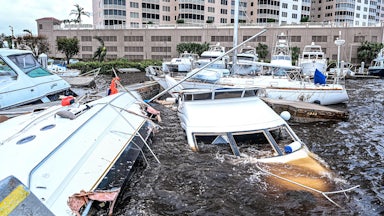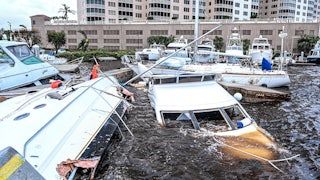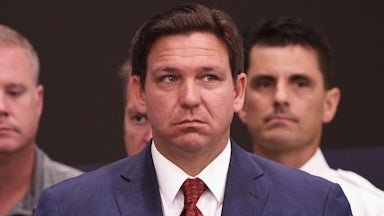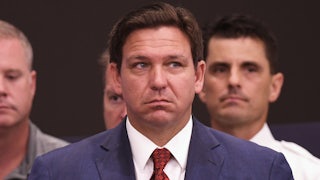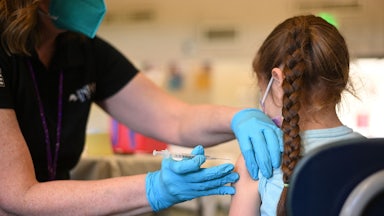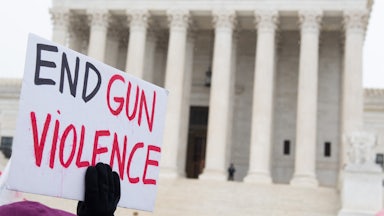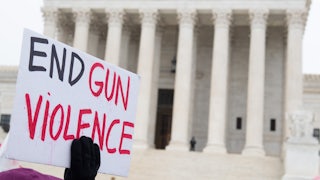This past week, as Florida’s recovery efforts from Hurricane Ian continued, Governor Ron DeSantis continued to do the one thing that nearly everyone in politics has to say he’s done well: dominate the news cycle. The governor has been many months in the spotlight, thanks to a media that’s more or less christened him the heir apparent to former President Donald Trump—an anointment that DeSantis has more or less taken in stride. Of course, long before he gets a shot at the White House, the governor will face Florida voters for reelection in less than a month. Despite his many controversies, recent polling suggests that he’s a sure bet to be reelected.
Against this backdrop, you might be wondering how it is that DeSantis is on a glide path to reelection. Why has a race that appeared to be one of the hottest in the country a year ago seemingly fizzled out? More critically, why has the Democratic nominee, Charlie Crist, a former governor himself, failed to resonate with an electorate familiar with him or conjure any heat in the spotlight for himself?
It truly is a puzzlement given his profile. Crist won statewide elections three times as a Republican between 2000 and 2010. He proved an adept vote-getter, the sort of centrist politician that Florida voters in both parties had traditionally swooned over. And in this most recent electoral tilt, Crist’s selling point was that he was a known quantity, with high name recognition and deep ties to the state’s political scene, uniquely skilled in his own right when it comes to gaining earned media—as well as defying partisan labels.
It’s this latter chapter in his political biography—his transpartisan journey—that has made Crist an object of fascination in recent years. A series of events including hugging President Obama led to Crist leaving the GOP and subsequently losing a Senate race as an independent. Once out of office, Crist became a Democrat in late 2012, after he had endorsed President Obama’s reelection campaign earlier that year.
When Crist joined the party, Florida seemed to be trending Democratic, with Bill Nelson getting easily reelected to the U.S. Senate in 2012, along with the party making gains in the state legislature and congressional delegation that year. Florida Democrats nominated Crist for governor in 2014 in what initially appeared to be a promising shot at unseating incumbent Rick Scott. Crist ran a vigorous and spirited campaign but ending up getting pipped at the post during what turned out to be a GOP wave election. Throughout that campaign, Crist touted his experience and centrist bona fides; Scott, a darling of the Tea Party movement, never made a move to the middle, yet still won.
Arguably, this was the moment that heralded all of the change that’s come to pass. Florida is a substantialy different place in 2022 than it was when Crist campaigned in 2014. Donald Trump twice won Florida’s Electoral College votes. The Sunshine State, in fact, was the only state heavily targeted by both parties where Trump performed better in 2020 than in 2016. In 2018, DeSantis won the statehouse—albeit by a very small margin—as a self-styled MAGA Republican, as Florida bucked that year’s national Democratic wave.
Following Trump’s increased margin in 2020, the real bombshell came. In December 2021, Republicans overtook Democrats in voter registration for the first time in the state’s modern history. It was a culmination of a long-standing campaign by the GOP to flip Florida from a purple state to a solidly red one, an effort that intensified after Obama’s 2012 victory in the state. In early 2022, Florida Democrats launched an effort to push back on GOP gains and encourage new registrants, but the effort has yet to bear fruit, as the Republican advantage in registered voters is now well over 100,000 statewide.
There is a sense that Democrats in Florida have fallen down on the job, lax in recognizing emerging trends and slow to pivot party operations to keep up with them. “Democrats in Florida are stuck 30 years in the past and haven’t been able to calculate voter registration and voting trends throughout the state, especially in exurban places,” said Dave Trotter, a political data scientist who correctly forecast the results of the last two election cycles in the state, which polling had largely gotten wrong. “In a state like Florida, which doesn’t have a strong geographical center, exurbs play an even larger role,” Trotter added.
Florida’s one statewide elected Democrat, Agriculture Commissioner Nikki Fried, made a bid for the governorship around the same time as Crist, who had spent the last six years as a member of Congress from the St. Petersburg-based 13th congressional district, renewed his interest in the statehouse. Seeing similarities with Joe Biden’s profile of experienced moderation following his successful presidential campaign, Florida Democrats coalesced around Crist’s candidacy. They might have misread the moment: In 2020, Biden actually did worse in Florida than Hillary Clinton had in 2016, and as noted above, it was the only state intensely targeted by Democrats in 2020 where the effort to match the prior presidential election’s watermark fell short.
Crist emptied his war chest to beat Fried in the primary, spending himself down to nearly zero cash on hand. But when he beat Fried by 24 points, it raised persistent and puzzling questions in Democratic circles about why he’d needed to spend so profligately in a race he won with such ease. Was his internal polling flawed, or did his campaign team think his general election prospects would be aided if his campaign was ever-present on local airwaves in August?
If decisions were made in support of the latter gamble, it hasn’t paid off. The end result of this spending bonanza has been a vanishing act, as Crist’s campaign went dark on television during the three critical weeks after he was nominated. At the same time, DeSantis’s campaign enjoyed high visibility and more activity, both with its media buys and with its earned media strategy. The anticipated Crist bounce from DeSantis’s Martha’s Vineyard stunt arrived but was not sustained, giving the Democratic hopeful a too brief turn in the sun.
The postprimary period for Crist was further complicated by an unforced error in Crist’s choice of a running mate. His decision to tap Miami-Dade Teachers Union head Karla Hernandez-Mats as the party’s lieutenant governor nominee created unneeded controversy and turned a week when Crist should have been on offense into a prolonged period of time spent on the back foot. Without elected experience and boasting the typical baggage that surrounds someone who has led a union, including defending a school employee accused of sexual assault, Hernandez-Mats has proven an ineffective surrogate at this point for the campaign.
Since that point, Governor DeSantis’s financial advantage has only become more pronounced: The incumbent now holds a 27-to-1 advantage in cash on hand. This has been exacerbated by Crist’s inability to earn media coverage to offset his financial disadvantage.
The perceived staleness of Crist’s approach may be demonstrative of shifting opinions among Floridians in their preferred style of candidate as well as ideology. When Crist arrived on the scene to become a GOP star, his timing was perfect: From the late 1990s through the early 2000s, Florida was a welcome home for his political aesthetic; his mushy moderateness was precisely the flavor preferred by Florida voters, be it Clintonian “third wave” types mass-produced by the then-ascendant Democratic Leadership Council or Republicans of John McCain’s patriotic and bipartisan-curious ilk.
But as in much of the country, political winds in Florida shifted abruptly with the Tea Party movement and Trump’s 2016 nomination. Crist himself has been a victim of that ideological drift and the sense among many observers that his era of genial moderation has passed in this state.
If he’s unable to will the Florida electorate to embrace the politics of his glory days, can Crist still rally and win this election? All hope isn’t yet lost. Florida has been a notoriously difficult state to poll in recent years, and polls might be off this time around as well. And crisis may yet beget an opportunity: The state’s growing property insurance emergency provided Crist with an issue that, in the wake of Hurricane Ian, is newly relevant.
Here, Crist may once again find himself the potential beneficiary of the good timing that launched his career, as the matter suddenly affords the former governor the chance to draw a contrast with the man he hopes to supplant. Earlier this year, DeSantis called a special session of the legislature to deal with property insurance, but the effort gave way to another political controversy: DeSantis’s blood-feud with Disney, which led to the legislature leaping to his beck and call to repeal the corporation’s special tax status and authority in Florida.
The sense among some observers is that with the property insurance crisis coming into focus as we approach Election Day, Crist might be able to seize on DeSantis’s inaction and how much his pet political obsessions have cost ordinary Floridians. However, with vote-by-mail ballots already distributed through much of the state, the window for a Crist comeback might be narrowing. If DeSantis is in fact reelected handily, questions will continue to grow over the Democrats’ approach to Florida and why they pinned their hopes of flipping the state to a candidate who picked a bad time to disappear from the race.

